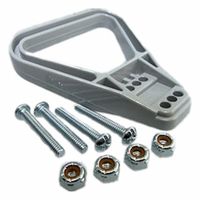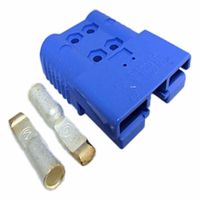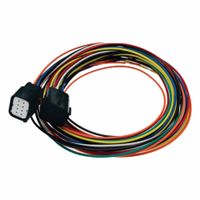Call +(254) 703 030 000 / 751 483 999 / 721 704 777
- Home
- Electrical
- Electrical Connectors Wiring Devices
- Modular Industrial Power Battery Connectors
.....Read More
Frequently Asked Questions
What are modular industrial power and battery connectors?
Modular industrial power and battery connectors are specialized components designed to facilitate the efficient and reliable transmission of electrical power and signals in industrial settings. These connectors are characterized by their modularity, allowing for customizable configurations to meet specific application requirements.
The modular design enables users to combine different modules, such as power, signal, data, and pneumatic connections, into a single connector housing. This flexibility simplifies installation, reduces wiring complexity, and enhances system scalability. The connectors are typically used in environments where robust and durable connections are essential, such as in manufacturing, automation, robotics, and energy storage systems.
Industrial power connectors are engineered to handle high current and voltage levels, ensuring safe and efficient power distribution. They are often equipped with features like locking mechanisms, environmental sealing, and resistance to vibration and mechanical stress, making them suitable for harsh industrial environments.
Battery connectors, a subset of these connectors, are specifically designed for connecting batteries to power systems. They ensure secure and efficient energy transfer, often incorporating features like quick disconnects, polarity protection, and high mating cycles to accommodate frequent connections and disconnections.
Both types of connectors are made from materials that provide excellent electrical conductivity and mechanical strength, such as copper alloys and high-grade plastics. They are also designed to comply with industry standards and certifications, ensuring compatibility and safety across various applications.
Overall, modular industrial power and battery connectors are essential components in modern industrial systems, providing reliable and flexible solutions for power and signal connectivity.
How do modular connectors differ from traditional connectors?
Modular connectors differ from traditional connectors in several key ways:
1. **Design and Structure**: Modular connectors, such as RJ45, RJ11, and RJ12, are typically smaller and more compact than traditional connectors. They are designed with a standardized form factor that allows for easy insertion and removal, often featuring a clip or latch mechanism to secure the connection.
2. **Versatility and Standardization**: Modular connectors are highly versatile and standardized, making them suitable for a wide range of applications, including telecommunications, networking, and audio equipment. Traditional connectors, on the other hand, often vary significantly in design and are typically application-specific.
3. **Ease of Use**: The plug-and-play nature of modular connectors allows for quick and easy installation and replacement, reducing downtime and maintenance efforts. Traditional connectors may require more complex assembly or disassembly processes.
4. **Scalability**: Modular connectors support scalability, allowing users to easily expand or modify systems by adding or replacing modules without overhauling the entire setup. Traditional connectors may not offer the same level of flexibility.
5. **Cost-Effectiveness**: Due to their standardized design and widespread use, modular connectors are often more cost-effective to produce and purchase compared to traditional connectors, which may require custom manufacturing.
6. **Applications**: Modular connectors are predominantly used in modern telecommunications and data networking, such as Ethernet cables and telephone lines. Traditional connectors are often found in older or specialized equipment, such as legacy audio-visual systems or industrial machinery.
7. **Durability and Reliability**: While both types can be durable, modular connectors are designed to withstand frequent connections and disconnections, making them more reliable for applications requiring regular reconfiguration.
Overall, modular connectors offer a more standardized, versatile, and user-friendly solution compared to traditional connectors, which are often more specialized and less adaptable.
What are the key components of a modular connector system?
A modular connector system is designed to provide flexibility, scalability, and ease of maintenance in various applications, such as telecommunications and networking. The key components of a modular connector system include:
1. **Connector Housing**: This is the outer shell that holds the internal components together. It provides mechanical protection and ensures proper alignment and mating with corresponding connectors. The housing is typically made from durable materials like plastic or metal.
2. **Contacts**: These are conductive elements within the connector that establish the electrical connection between the mating connectors. Contacts are usually made from metals like copper or gold-plated alloys to ensure good conductivity and corrosion resistance.
3. **Insulation**: Insulation materials are used to separate and protect the contacts within the connector. This prevents short circuits and ensures reliable signal transmission. Insulation is typically made from plastic or rubber materials.
4. **Cable Termination**: This component involves the method by which cables are attached to the connector. Termination techniques can include crimping, soldering, or insulation displacement, depending on the application and connector type.
5. **Locking Mechanism**: A locking mechanism ensures that the connectors remain securely mated during operation. This can include latches, clips, or screws that prevent accidental disconnection.
6. **Modular Inserts**: These are interchangeable components that allow customization of the connector system to accommodate different types of signals or power requirements. Inserts can be swapped out to change the configuration of the connector.
7. **Shielding**: Shielding is used to protect the connector from electromagnetic interference (EMI) and radio frequency interference (RFI). This is often achieved with metal shells or foil wraps around the connector.
8. **Strain Relief**: This component prevents damage to the cable and connector by absorbing mechanical stress and reducing the risk of disconnection or breakage.
These components work together to create a reliable and adaptable connection system suitable for a wide range of applications.
How do you choose the right connector for industrial applications?
To choose the right connector for industrial applications, consider the following factors:
1. **Application Requirements**: Determine the specific needs of the application, including the type of signals (power, data, or mixed), voltage, and current ratings.
2. **Environmental Conditions**: Assess the operating environment. Consider temperature extremes, exposure to moisture, dust, chemicals, and potential mechanical stress. Choose connectors with appropriate IP ratings for protection against these elements.
3. **Material and Durability**: Select materials that can withstand the environmental conditions. Metal connectors offer robustness, while plastic connectors provide corrosion resistance and are lightweight.
4. **Size and Space Constraints**: Evaluate the available space for the connector. Compact designs are essential for space-limited applications, while larger connectors may be suitable for high-power requirements.
5. **Ease of Installation and Maintenance**: Consider connectors that are easy to install and maintain. Features like tool-less assembly, quick disconnects, and clear labeling can reduce downtime and labor costs.
6. **Electrical Performance**: Ensure the connector meets the necessary electrical specifications, including impedance, shielding for EMI/RFI protection, and contact resistance.
7. **Mechanical Performance**: Look for connectors with high mating cycles, secure locking mechanisms, and vibration resistance to ensure reliability and longevity.
8. **Standards and Certifications**: Verify compliance with industry standards and certifications, such as UL, CE, or RoHS, to ensure safety and compatibility.
9. **Cost and Availability**: Balance the cost with performance requirements. Consider the availability of the connector and potential lead times.
10. **Future-Proofing**: Anticipate future needs, such as increased data rates or power requirements, to avoid premature obsolescence.
By carefully evaluating these factors, you can select a connector that ensures reliability, efficiency, and safety in industrial applications.
What are the benefits of using modular connectors in demanding environments?
Modular connectors offer several benefits in demanding environments:
1. **Flexibility and Customization**: Modular connectors allow for easy customization and reconfiguration, accommodating various applications and requirements. This flexibility is crucial in environments where equipment and systems frequently change or need upgrades.
2. **Ease of Maintenance and Repair**: They simplify maintenance and repair processes. Faulty modules can be replaced individually without disturbing the entire system, reducing downtime and maintenance costs.
3. **Scalability**: Modular connectors support scalability, enabling systems to expand or contract as needed. This is particularly beneficial in environments where future growth or changes are anticipated.
4. **Durability and Reliability**: Designed to withstand harsh conditions, modular connectors often feature robust materials and sealing technologies that protect against dust, moisture, vibration, and temperature extremes, ensuring reliable performance.
5. **Improved Signal Integrity**: They maintain high signal integrity, crucial in environments with significant electromagnetic interference. This ensures accurate data transmission and reduces the risk of signal loss or degradation.
6. **Space Efficiency**: Modular connectors are compact, saving valuable space in equipment and installations. This is advantageous in environments where space is limited or at a premium.
7. **Cost-Effectiveness**: By allowing for targeted upgrades and repairs, modular connectors can reduce overall system costs. Their durability also means fewer replacements and lower long-term expenses.
8. **Standardization and Compatibility**: Many modular connectors adhere to industry standards, ensuring compatibility with a wide range of devices and systems. This standardization facilitates integration and interoperability in complex environments.
9. **Enhanced Safety**: They often include features that enhance safety, such as secure locking mechanisms and protection against accidental disconnection, which are critical in demanding and hazardous environments.
Overall, modular connectors provide a versatile, reliable, and efficient solution for connecting systems in challenging conditions.
How do you ensure proper installation of modular connectors?
To ensure proper installation of modular connectors, follow these steps:
1. **Select the Right Connector**: Choose the appropriate type and category of modular connector (e.g., RJ45, RJ11) based on the application and cable type (e.g., Cat5e, Cat6).
2. **Prepare the Cable**: Strip the cable jacket carefully to expose the wires without damaging them. Maintain the twist of the pairs as close to the termination point as possible to minimize crosstalk.
3. **Arrange the Wires**: Untwist the pairs and arrange the wires according to the wiring standard required (T568A or T568B for Ethernet cables). Ensure the wires are straight and in the correct order.
4. **Trim the Wires**: Cut the wires to an even length, leaving enough length to reach the end of the connector but not too long to avoid excess wire inside the connector.
5. **Insert the Wires**: Insert the wires into the modular connector, ensuring each wire is fully seated in its respective slot. The cable jacket should be inside the connector to provide strain relief.
6. **Crimp the Connector**: Use a quality crimping tool designed for the specific connector type. Apply firm, even pressure to crimp the connector onto the cable, ensuring all pins make contact with the wires.
7. **Inspect the Connection**: Visually inspect the connector to ensure all wires are in the correct order and fully seated. Check that the crimp is secure and the cable jacket is properly clamped.
8. **Test the Connection**: Use a cable tester to verify the integrity of the connection. Ensure there are no open circuits, shorts, or miswires.
9. **Label the Cable**: For organization and future troubleshooting, label the cable with relevant information such as its destination or purpose.
10. **Document the Installation**: Keep records of the installation details, including the type of connectors used and test results, for future reference.
What maintenance is required for modular industrial connectors?
Maintenance of modular industrial connectors is crucial to ensure their reliability and longevity. Here are the key maintenance tasks:
1. **Regular Inspection**: Conduct visual inspections to check for signs of wear, corrosion, or damage. Look for loose connections, broken parts, or any discoloration that might indicate overheating.
2. **Cleaning**: Keep connectors clean from dust, dirt, and debris. Use appropriate cleaning agents that do not leave residues. For metal parts, use a contact cleaner to remove oxidation and improve conductivity.
3. **Lubrication**: Apply dielectric grease or appropriate lubricants to prevent corrosion and ensure smooth mating and unmating of connectors. Avoid over-lubrication as it can attract dust.
4. **Tightening**: Ensure that all screws, bolts, and fasteners are properly tightened to maintain secure connections. Loose connections can lead to increased resistance and potential failure.
5. **Replacement of Damaged Parts**: Replace any damaged or worn-out components immediately. This includes seals, gaskets, and any other parts that show signs of deterioration.
6. **Testing**: Perform regular electrical testing to ensure connectors are functioning correctly. This includes continuity tests, insulation resistance tests, and checking for voltage drops.
7. **Environmental Protection**: Ensure that connectors are adequately protected from environmental factors such as moisture, chemicals, and extreme temperatures. Use appropriate enclosures or protective covers if necessary.
8. **Documentation**: Keep detailed records of maintenance activities, including inspections, cleaning, and any replacements or repairs. This helps in tracking the performance and scheduling future maintenance.
9. **Training**: Ensure that personnel handling connectors are properly trained in maintenance procedures to prevent mishandling and ensure safety.
By adhering to these maintenance practices, the performance and lifespan of modular industrial connectors can be significantly enhanced.




